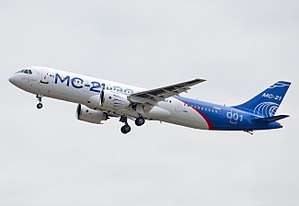Irkut MC-21
The Irkut MC-21 (Russian: Иркут МС-21) is a Russian single-aisle twinjet airliner, developed by the Yakovlev Design Bureau and produced by its parent Irkut, a branch of the United Aircraft Corporation (UAC). The initial design started in 2006 and detailed design was ongoing in 2011. After delaying the scheduled introduction from 2012 to 2020, Irkut rolled out the first MC-21-300 on 8 June 2016 and first flew the aircraft on 28 May 2017. It has a carbon fibre reinforced polymer wing and is powered by Pratt & Whitney PW1000G or Aviadvigatel PD-14 turbofans. The standard MC-21-300 has a capacity of 132–163 passengers in a two-class configuration and 165–211 in a single class, and a range up to 6,000–6,400 km (3,200–3,500 nmi). It will be followed by a shortened MC-21-200 version. By July 2018, it had received 175 firm orders and recorded nearly 150 intentions.
| MC-21 | |
|---|---|
 | |
| The MC-21 during its maiden flight on 28 May 2017 | |
| Role | Narrow-body twin-engine jet airliner |
| National origin | Russia |
| Manufacturer | United Aircraft Corporation (UAC)[1] |
| Designer | Irkut Corporation and Yakovlev Design Bureau[1] |
| First flight | 28 May 2017[2] |
| Introduction | planned 2021[3] |
| Status | Flight testing [4] |
| Number built | 4 as of November 2019[5] |
| Program cost | 438 billion rubles (Oct 2018, US$6.6 Bn)[6] |
| Unit cost | |
Naming
In Russian: МС‑21 "Магистральный Самолёт 21 века" – "Magistralny Samolyot 21 veka" translates as "mainline aircraft of the 21st century".[9] It is marketed in the West as the MC-21,[7][10] despite the aircraft's original Russian model name being МС-21, which transliterates as MS-21.
In 2013, Russian deputy premier Dmitry Rogozin indicated that it will be designated Yak-242 once it enters serial production, the name of a 1990s proposal of an aircraft of similar size.[11] In 2014, Oleg Demchenko, the president of Irkut at the time, also preferred the Yak-242 name, claiming it would better reflect the design bureau behind the aircraft, however he has also said that any of these renaming decisions would be after the aircraft first flight and certification work.[12]
Development

In 2006, the UAC design goal was to seat 130–170 passengers over 5,000–6,350 km (2,700–3,430 nmi) to replace aging Tu-154, 20–25% more efficiently than the Airbus A320 and B737NG competitors with 15% lower weight, 20% lower operating costs and 15% lower fuel consumption, it was due to enter service in 2012 for an initial target price of US$35 million, $20 million below the similar 737-700.[13] The program was launched in 2007, planning a 2016 introduction.[9] Those goals were reiterated in 2008, except for the general efficiency gain lowered to 10–15%.[14]
In 2009, the MC-21 was in the "pre-design" phase, with projected completion of the first prototype in 2013 and the first flight in 2014.[15] By June 2011, the "pre-design" phase was completed and the "working design" stage was under way with three-dimensional models and drawings for subcontractors and suppliers, to be completed by mid-2012.[16] In February 2012, Russian deputy prime minister Dmitry Rogozin announced it was slated to begin certification tests in 2015/2016 and to enter production in 2020.[17]
On 8 June 2016, the -300 was rolled-out in Irkutsk, East Siberia, six years after program launch and with 175 orders. It could be the first commercial aircraft with an out of autoclave composite manufacturing for its wings. The program faces domination of the single-aisle market by Airbus and Boeing. Russian protectionism is hampering access to critical western suppliers for the avionics, landing gear, hydraulics, power systems and engines. Its introduction was delayed to the end of 2018.[18][19] It is intended to rival the Airbus A320neo or Boeing 737 MAX and will replace the outgoing Tu-134, Tu-154, Tu-204 and Yak-42.[20]
Ground testing

In February 2017, it passed 90% of the static ultimate load test (150% of the highest load in operation) at the TsAGI but failed the 100% test for which the wingbox will need 25kg reinforcements: this is common for new airliners like the Airbus A380, Boeing 787 or Mitsubishi MRJ, aiming for the smallest possible margin to avoid excess weight; it passed the limit load test (highest load during flight) which enables flight testing which should start in April.[21] Cracks developed at the point of contact between the titanium beam and the composite wing skin in the wingbox.[9] The reinforced wingbox withstood a load exceeding specifications without damage in mid-November at TsAGI Moscow.[22]
In May 2017, it was undergoing systems ground testing including its auxiliary power unit and taxiing tests.[23] After completing taxi and runway roll tests, its maiden flight was scheduled for late May 2017 with Pratt & Whitney Geared Turbofan engines, certified in September 2016 in Russia. The Russian certification is targeted for 2018 and the European Aviation Safety Agency certificate for 2019.[9]
Flight testing
On 28 May 2017 MC-21 made its successful maiden flight in Irkutsk.[2] Compared with recent 3-4 hour maiden flights of western types, this first flight was brief at 30-minute and low, reaching a 1,000 m altitude and 300 km/hour.[24] The maiden flight was originally scheduled for December 2016, then to April before finally taking place in May.[25]
Following this maiden flight, trade and industry minister Denis Manturov claims it will have 12–15% lower operating costs than contemporaries, generating a demand for over 1,000 MC-21s between 2017 and 2037.[26] Aeroflot expects delivery of the first aircraft through Rostec subsidiary Aviakapital leasing in 2019.[9] Its early production rate is projected for 20 aircraft per year.[27]
In August 2017, the first prototype performed nine test flights, analysing stability and controllability in various configurations, altitude, altitude/speed sensors accuracy and engine operation. Its software is adjusted by the results as it is fitted with over 500 strain gauges measuring in-flight loading on the airframe, to verify the initial design, for "several weeks". A second prototype is finalised while three other prototypes are undergoing construction; production of 70 MC-21s annually is planned for 2024.[28] Irkut began the second testing phase on 13 September with an eventless 2h flight.[29] The phase will extend the mass, centering, speed and altitude envelope.[30]
In October 2017, the first prototype flew from Irkutsk Aviation Plant to Moscow Ramenskoye Airport to continue testing at the Gromov Flight Research Institute, a 6 h flight over 4,500 km (2,400 nmi) at 10,000 m (33,000 ft), piloted by Oleg Kononenko.[31] The flight test programme started on 2 November with a 3h flight reaching 12,000 m (39,400ft).[32] Before being flown to Moscow, 20 flights were conducted in Irkutsk. In November, the second prototype was prepared for flight-tests, followed in 2018 by the third for which final assembly has started.[33]
EASA approval is targeted for mid-2020.[33] Certification testing was to start at the end of 2018 for a mid-2019 Russian type certification after a 1,150 flights effort. Entry into service was then planned for the second half of 2019 with the first five deliveries and within five years UAC plans to ramp up production to 70 aircraft per year.[34]
The second test aircraft was in final assembly in January 2018 and was to join the flight-test campaign in the first quarter.[34] It was to fly in late February or early March 2018.[35] Its construction was completed by March end.[36] It was scheduled to fly in April 2018, and the third in the 2018 fourth quarter.[37] It made its first flight on 12 May for 1h 7min, reaching 3,000 m (9,800 ft) and 215 kn (398 km/h), checking its landing gear retraction and testing wing configurations.[38] On 20 July 2018, it flew from Irkutsk to the Gromov Flight Research Institute near Moscow in six hours.[39]
Production started in 2018, certification slipped into late 2019 and the first delivery to 2020.[37] For three years after 2018, UAC plans to invest ₽56.4 billion ($899 million) for the MC-21.[40] By October 2018, two EASA test pilots and a test engineer test flew the plane in preparation for European certification.[41] On 3 December, a fuselage was delivered to the Central Aerohydrodynamic Institute at Moscow-Zhukovsky for fatigue testing: repetitive loads will simulate 180,000 cycles. By then, the third flying prototype was assembled, its systems installed and it was undergoing final adjustments, a fourth test aircraft was in assembly, as the first production fuselage.[42] After completing assembly, the third MC-21 was transferred to the flight-test station on 25 December.[43]
By early 2019, the two prototypes had completed 122 test sorties, and following Western sanctions against Russia, 1.6 billion roubles ($24.2 million) of additional subsidies were allocated to the program for 2019, before 4.11 billion roubles in 2020 and 4.81 billion roubles in 2021: Russian content was aimed at 97% by 2022.[6] In February 2019, the EASA completed initial certification testing with 2.5-4h flights up to 3,000-10,000m (10,000-33,000ft), including high angle-of-attack and stall onset.[44] By then, certification trials were expected to end in the second half of 2020 before first delivery to Aeroflot by year end.[45]
On 18 February 2019, Rostec delayed entry into service another year to 2021 due to US sanctions, while another 240-250 billion rubles ($3.62-3.78 billion) is needed to complete its development.[3] On 16 March 2019, the third test aircraft, which has been fully fitted out with a passenger cabin, made its maiden flight.[46] After painting at Ulyanovsk, on 13 May 2019 it joined the other two test aircraft at Moscow-Zhukovsky Airport, where the certification programme is being conducted.[47]
On 17 September 2019, the third test aircraft has made its first international flight from Moscow-Zhukovsky to Istanbul Atatürk Airport.[48] The aircraft was presented to Turkish airlines at Teknofest Istanbul, and co-production projects were proposed to Turkey.[49] The fourth flight-test aircraft was rolled out on 28 November 2019,[5] and performed its first flight on 25 December 2019.[50]
In January 2020, Irkut had received the first PD-14 engines for installation.[51]
Introduction
Aeroflot will lease 50 MC-21-300 from Aviakapital for 12 to 18 years and a monthly lease below $437,282 each, to be delivered from the first quarter of 2020 to the third quarter of 2026, with EASA certification from early 2021. Powered by PW1400Gs or possibly PD-14s for the second half, Irkut guaranteed a less than 9,865 kg (21,749 lb) fuel burn on a 3,240km (1,750nmi) route with a 14 kn tailwind. They will be guaranteed to reach 2,100h and a dispatch reliability of 96% for the first year, rising to 2,900h and 97% in the second year then 3,750h and 98.5% in the third year.[52]
In October 2018, fuselage panels for the first customer MC-21 were completed by United Aircraft Corporation subsidiary Aviastar.[53] In early 2019, the annual output was targeted from 20 initially to 72 airframes in 2025, towards 100 and possibly 120 later for a forecast of 850 deliveries.[6]
Design


The design is based on the never-realized, twin-engine Yakovlev Yak-242 as a development of the three-engine Yakovlev Yak-42.[11]
Airframe
In March 2008, Sukhoi was selected to design and produce the carbon fibre composite wings.[14] The UAC subsidiary AeroComposit developed the vacuum infusion process to produce the wingbox and wing panels. The vertical and horizontal fins and wingbox are also composite and the high aspect ratio wing is a supercritical airfoil.[9] The MC-21 design is more innovative than the C919: it is the only airliner with a carbon fibre wingbox made with resin infused dry fibre, cured in an oven out of autoclave.[54] The initial design was including ~33% composite materials, increasing to 40–45% with the composite wing.
By January 2019, U.S. sanctions against Russia have interrupted the supply of foreign raw materials, on which the UAC relied to produce composite parts. The UAC started looking for either domestically produced or Chinese replacements, maintaining that the wing box and consoles would still consist of polymeric composites. By then, a metal wing was "no longer on the agenda" according to the Central Aerohydrodynamic Institute (TsAGI).[55] In March 2019, AeroComposit reported that it had produced the first fuselage centre section and wing box from domestic materials.[56]
The fuselage of the MC-21 is mostly made of lightweight aluminium–lithium alloy, which accounts for 40% of the airframe's structural weight.[57] It is 11 cm (4.3 in) wider than the A320/C919 and 27 cm (11 in) wider than the 737, for a 61 cm (24 in) aisle allowing passing others or a trolley.[54] Its 79.25 t (174,700 lb) MTOW is the same as the almost 5 m (16.5 ft.) shorter A320neo, and is 3 t (6,600 lb) lighter than the almost 3 m (9.8 ft) shorter 737-8, for similar two-class layouts of 162 to 165 while the 737-8 and A320neo have 200 nmi (370 km) more range.[34] The MC-21 is a low-wing cantilever monoplane with a composite structure, a tricycle landing gear, powered by two wing-mounted turbofan engines and with a 3.81 m (150 in) wide cabin.
Engines
The 130 kN (30,000 lbf) thrust class Pratt & Whitney PW1000G was selected in December 2009.[58]
The Russian engine will be the 8–16 tf (18,000–35,000 lbf) Aviadvigatel PD-14.[59] United Engine Corporation (UEC) planned to deliver five PD-14s for the MC-21 by the end of 2018, to start flight tests in 2019 for the MC-21 variant certification in 2021.[60] By October 2018, the PD-14 had received its Rosaviatsia type certification.[61] By October 2019, PD-14 flight-testing on the MC-21 was delayed until 2020.[62]
Systems
In August 2009, Hamilton Sundstrand, a subsidiary of United Technologies, announced it will provide electric power generation and distribution equipment for $2.3 billion over 20 years of production.[63] Rockwell Collins and its Russian partner Avionika were selected to supply the MC-21's avionics.[64] Honeywell, Thales and Elbit Systems supplies avionics with 9 X 12 in multifunction displays, electronic flight bags, synthetic vision and enhanced vision systems. The MC-21 will be the first airliner with active sidesticks, supplied by UTC Aerospace Systems.[9] It has Fly-By-Wire controls.[54] It has a glass cockpit with side-stick controls and an optional Head-up display.
Goodrich Corporation, also a subsidiary of United Technologies, along with Aviapribor was selected to provide the flight control system actuators.[65] Zodiac Aerospace, Eaton and Meggitt provide other components.[9] Interior furnishings will come from Zodiac Aerospace, coordinated from C&D Zodiac in Huntington Beach, California. Innovations from Zodiac Aerospace in Carson, California, will be incorporated in the water and waste systems.
There are two types of auxiliary power units (APU) designed with specifications suitable for MC-21: HGT750 from Honeywell Aerospace[66] and TA18-200 developed by Aerosila.[67]
Variants
In 2009, the MS-21-200 was designed around 150 passengers in single-class configuration, to be followed by a 181-seat -300 and 212-seat -400 with basic and extended-range models, plus a very-long-range MS-21-200LR[15]
- MC-21-300
- Standard model, 163 passengers in two class, up to 211, up to 6,000 km (3,200 nmi) range
- MC-21-200
- Shortened version with 132 passengers in two class, up to 165, up to 6,400 km (3,500 nmi) range
Proposed
Initially a 132-seats MC-21-100 variant was planned but then superseded by the Superjet 100 development.[68] The small variant with a capacity of 130- to 150-seat was proposed with commonality with the Sukhoi Superjet 130.[69]
UAC considers more developments for the MC-21 by 2035. These include: a -400 with 18 tf (40,000 lbf) engines for a 105 t (231,000 lb) MTOW, a -500, a -600 with 20–25 tf (44,000–55,000 lbf) engines, and a -700 with 30 tf (66,000 lbf) engines, as well as a MC-21X with a 155 t (342,000 lb) tons MTOW for a 9,000–10,000 km (4,900–5,400 nmi) km range.[70] Ilyushin Finance wants a MC-21-400 stretch for up to 256 seats and plans to buy 20 to 60 of them.[71] The 250-passenger MC-21-400 single-aisle twinjet could be jointly produced in the United Arab Emirates.[72]
Orders
By the end of the 2013 MAKS Air Show there were 175 firm orders including 50 for Rostec subsidiary Aviakapital leased to Aeroflot and 35 more with PD-14 engines for governmental customers, 50 for Ilyushin Finance (10 leased to Red Wings Airlines and six to Transaero), 30 for VEB Leasing (10 leased to UTair Aviation and 6 to Transaero) and 10 for IrAero with an agreement for 20 others leased from Sberbank of Russia, for a potential 195 orders.[73] Transaero bankrupted in 2015.
In June 2016, Azerbaijan Airlines has tentatively signed to lease ten -300s from Ilyushin Finance.[74] By July 2018, it had received 175 firm orders and recorded nearly 150 intentions.[75]
At the 2019 MAKS Air Show, at Zhukovsky International Airport, Moscow, Bek Air signed a letter of intent for ten Irkut MC-21 aircraft, Yakutia Airlines likewise signed for five aircraft and an undisclosed customer for a further five aircraft. Delivery of the new aircraft was expected to be in the second half of 2021.[76]
| Date | Airline | EIS | Orders | ||||
|---|---|---|---|---|---|---|---|
| -200 | -300 | Options | Total | ||||
| 21 Jul 2010 | TBA | — | 3 | 2 | 5 | ||
| 21 Jul 2010 | TBA | — | 30 | 30 | 60 | ||
| 1 Sep 2010 | 2019 | — | 50 | — | 50[77] | ||
| 18 Aug 2011 | 2019 | — | 28 | 22 | 50[78] | ||
| 23 Aug 2011 | 2019 | 15 | 35 | 35 | 85[79] | ||
| 16 Sep 2011 | 2019[80][81] | — | 10 | 10 | 20[82][lower-alpha 1] | ||
| 27 Aug 2013 | TBA | — | 10 | — | 10[lower-alpha 2] | ||
| 29 Aug 2013 | 2019 | — | 20 | — | 20[84] | ||
| 30 Aug 2013 | 2019 | — | 16 | — | 16[85][lower-alpha 3] | ||
| 9 Sep 2015 | TBA | — | 6 | 4 | 10[86] | ||
| 8 Jun 2016 | 2019 | — | 10 | — | 10[74] | ||
| 18 Jul 2017 | 2021 | — | 15 | — | 15[87][88][lower-alpha 3] | ||
| 19 Jul 2017 | 2022 | — | 6 | — | 6[89][lower-alpha 3] | ||
| 19 Jul 2017 | 2022 | — | 3 | — | 3[89] | ||
| 19 Jul 2017 | 2023 | — | 3 | 3 | 6[90][91][lower-alpha 3] | ||
| Total without duplicates | 175[75] | ||||||
| Letters of Intention signed | |||||||
| 16 Jul 2018 | 2020s | — | 10 | — | 10[lower-alpha 4] | ||
| 11 Nov 2018 | 2020s | — | 10+ | — | 10[93] | ||
| 30 August 2019 | TBA | — | 5 | — | 5[94] | ||
| 30 August 2019 | TBA | — | 10 | — | 10[94] | ||
- Launch operator[83] through Sberbank of Russia
- through VEB Leasing
- through Ilyushin Finance
- to be operated by a subsidiary from the 2020s, Aero Peru.[92]
Specifications
| Variant | MC-21-200 | MC-21-300 |
|---|---|---|
| Cockpit crew | 2 | |
| 2-class seats | 132 (12J + 120Y) | 163 (16J + 147Y) |
| 1-class seats | 165 @ 29–28” | 211 @ 29–28” |
| Cargo capacity | 34 m3 (1,200 cu ft) - 5 LD3-45 | 49 m3 (1,700 cu ft) - 9 LD3-45 |
| Length | 36.8 m (121 ft) | 42.2 m (138 ft) |
| Wingspan | 35.9 m (118 ft) | |
| Height | 11.5 m (38 ft) | |
| Fuselage width | 4.06 m (13.3 ft) | |
| Cabin width | 3.81 m (12.5 ft) | |
| Maximum take-off weight | 72,560 kg (159,970 lb) | 79,250 kg (174,720 lb) |
| Maximum landing weight | 63,100 kg (139,100 lb) | 69,100 kg (152,300 lb) |
| Maximum payload | 18,900 kg (41,700 lb) | 22,600 kg (49,800 lb) |
| Fuel capacity | 20,400 kg (45,000 lb) | |
| Turbofans (x 2) | Aviadvigatel PD-14[96] / Pratt & Whitney PW1400G[97] | |
| Max. thrust (x 2) | PW1428G: 28,000 lbf (120 kN) | PW1431G: 31,000 lbf (140 kN) |
| 2-class range | 6,400 km (3,500 nmi) | 6,000 km (3,200 nmi) |
See also
Aircraft of comparable role, configuration and era
- Airbus A220-300
- Airbus A320neo family
- Boeing 737 MAX
- Comac C919
- Embraer E-Jet E2
Related lists
Notes
References
- "MC-21". United Aircraft Corporation.
- "First flight of MC-21" (Press release). United Aircraft Corporation. 28 May 2017.
- Steve Trimble (18 February 2019). "U.S. Sanctions Trigger One-Year MC-21 Schedule Delay". Aviation Week Network.
- "Irkut extends MC-21 flight-test envelope". Flight Global. 15 June 2017.
- David Kaminski-Morrow (29 November 2019). "Irkut rolls out fourth test MC-21". Flightglobal.
- Vladimir Karnozov (29 January 2019). "Kremlin Boosts Funding for MC-21". AIN online.
- "Irkut to build first MC-21 by year-end". Flight Global. 19 June 2013.
- "MC-21 Roll Out". AirInsight. 8 June 2016.
- Maxim Pyadushkin (24 May 2017). "UAC's MC-21 About To Make Its First Flight". Aviation Week & Space Technology.
- "Russian industry makes push into the Iranian market". IHS Jane's Defence Weekly. 21 November 2016. Archived from the original on 17 September 2017.
- David Kaminski Morrow (25 October 2013). "Russia to revive Yak-242 name for Irkut MC-21". Flight Global.
- "Irkut still contemplating MC-21 name change". Flightgobal. 5 June 2014.
- "MS-21 jetliner key project for Russia's aircraft industry - executive". Sputnik News. 12 December 2006.
- RIA Novosti (13 March 2008). "Sukhoi wins bid to build wings for new MS-21 passenger plane". Sputnik News.
- "Russia's United Aircraft reaches maturity". Flight Global. 11 August 2009.
- Alan Dron (19 June 2011). "PARIS: Irkut forges ahead with MS-21 work". Flight Global.
- Vladimir Karnozov (29 February 2012). "Russia Maintains Big Plans Despite Last Year's Failures". Aviation International News.
- Stephen Trimble (8 June 2016). "PICTURES: Irkut rolls-out MC-21 airliner in bid for single-aisle share". Flight International.
- Gregory Polek (8 June 2016). "Russia's MC-21 Rolls Out in Irkutsk". Aviation International News.
- "MC-21: Russian high-tech plane rolls out to challenge Airbus 320". RT (TV network). 8 June 2016.
- Bjorn Fehrm (5 April 2017). "Irkut MC-21 missing ultimate load test". Leeham Co.
- David Kaminski-Morrow (23 November 2017). "MC-21 wing box passes latest flight-load test". Flight Global.
- David Kaminski-Morrow (15 May 2017). "MC-21 undergoes taxiing and ground tests". Flight Global.
- Gleb Stolyarov and Jack Stubbs (28 May 2017). "Russia squares up to Boeing, Airbus with maiden jet flight". Reuters.
- "MC-21 airliner makes first test flight—source". TASS. 28 May 2017.
- David Kaminski-Morrow (29 May 2017). "Russian ministry outlines demand forecast for MC-21". Flight Global.
- "Can Russia make the MC-21 a sales success?". Flight In ternational. 2 June 2017.
- David Kaminski-Morrow (17 August 2017). "Irkut readies second MC-21 for test flights". Flight Global.
- David Kaminski-Morrow (13 September 2017). "MC-21 embarks on new flight-test phase". Flight Global.
- "Irkut Corporation starts the second stage of MC-21 flight tests" (Press release). United Aircraft Corporation. 13 September 2017. Retrieved 28 December 2019.
- David Kaminski-Morrow (17 October 2017). "Irkut conducts long MC-21 flight to Gromov test centre". Flightglobal.
- David Kaminski-Morrow (3 November 2017). "MC-21 begins flight-test programme from Gromov". Flight Global.
- David Kaminski-Morrow (11 November 2017). "Second MC-21 shortly heading for flight test". Flight Global.
- Jens Flottau, Maxim Pyadushkin and Michael Bruno (2 January 2018). "MC-21 Narrowbody Flight Tests Symbolize Russian Sector Ambitions". Aviation Week & Space Technology.
- David Kaminski-Morrow (9 January 2018). "Second MC-21 to fly around end-February: Rogozin". Flight Global.
- "Irkut Corporation completed the construction of the second MC-21-300 aircraft" (Press release). Irkut Corporation. 25 March 2018. Retrieved 28 December 2019.
- Thierry Dubois (9 April 2018). "Russian Industry Gears Up To Supply MC-21's Composites". Aviation Week Network.
- David Kaminski-Morrow (12 May 2018). "Second MC-21 commences flight tests". Flight Global.
- "The second MC-21-300 test aircraft has flown nonstop from Irkutsk to Zhukovsky" (Press release). Irkut Corporation. 20 July 2018. Retrieved 28 December 2019.
- Vladimir Karnozov (9 July 2018). "Kremlin Boosts Effort toward 'Indigenization' of SSJ100". AIN online.
- David Kaminski-Morrow (26 September 2018). "EASA crew test-flies MC-21 ahead of certification bid". Flight Global.
- David Kaminski-Morrow (4 December 2018). "Fatigue-test MC-21 delivered to Moscow institute". Flight Global.
- David Kaminski-Morrow (26 December 2018). "Third assembled MC-21 moves to flight line". Flight Global.
- David Kaminski-Morrow (13 February 2019). "EASA completes initial MC-21 flight-test evaluation". Flight Global.
- Gregory Polek (13 February 2019). "EASA Personnel Perform First MC-21 Certification Flights".
- Kaminski-Morrow, David (16 March 2019). "Third test MC-21 lifts off on maiden flight". Flightglobal.com.
- Kaminski-Morrow, David (13 May 2019). "Cabin-fitted MC-21 flown to Moscow for tests". Flightglobal.com.
- "Russia's newest passenger jet makes first international flight". rt.com. 19 September 2019.
- content provided by a third party (23 October 2019). "Irkut MC-21-300 makes its first international flight". Flightglobal.
- "The fourth MC-21-300 aircraft joined the flight test program" (Press release). Irkut Corporation. 25 December 2019. Retrieved 28 December 2019.
- David Kaminski-Morrow (29 January 2020). "Irkut receives first PD-14 engines for installation on MC-21". Flightglobal.
- David Kaminski-Morrow (4 June 2018). "Aeroflot outlines performance expectations for MC-21s". Flight Global.
- "Aviastar completes fuselage panels for first serial MC-21". Flightglobal. 12 October 2018.
- Bjorn Fehrm (3 January 2018). "United Aircraft's and COMAC's eventful year". Leeham.
- Vladimir Karnozov (24 January 2019). "U.S. Sanctions Force MC-21 Course Correction". AINonline.
- "Первые детали крыла МС-21 из российских композитов уже изготовлены". Aviation Explorer (in Russian). 22 March 2019.
- Karnozov, Vladimir (5 November 2007). "Russia to adopt composite wing and aluminium fuselage for next narrowbody". Flightglobal.
- "Pratt & Whitney PW1000G Engine Selected to Power Russia's Irkut MS-21 Aircraft" (Press release). 10 December 2010. Archived from the original on 24 October 2017. Retrieved 15 May 2017.
- "Second borderline is behind" (Press release). Perm Engine Company. 26 March 2010. Archived from the original on 24 October 2017. Retrieved 15 May 2017.
- David Kaminski Morrow (26 January 2018). "Irkut signs for MC-21's initial PD-14 flight-test engines". Flightglobal.
- David Kaminski Morrow (19 October 2018). "PD-14 engine for MC-21 secures Russian certification". Flightglobal.
- David Kaminski Morrow (9 October 2019). "Flight-test PD-14 engines edge towards MC-21 installation". Flightglobal.
- "Hamilton Sundstrand Announces $2.3B Deal With Irkut". Hartford Courant. 21 August 2009. Archived from the original on 24 October 2017. Retrieved 15 May 2017.
- "Western next generation engines power to MS-21 and C919 selection". Flight Global. 16 December 2009.
- "SINGAPORE 2010: Goodrich wins MS-21 flight control system deal". Flight Global. 1 February 2010.
- "Irkut MC-21 — aeronautica.online". aeronautica.online.
- "Development of auxiliary power unit for MS-21 aircraft will be completed in November - News - Russian Aviation - RUAVIATION.COM". www.ruaviation.com.
- "Is Russian MC-21 Good Enough to Join the Oligopolistic Market?". Aviation Voice. 17 August 2016.
- "Russia's United Aircraft to develop new twin-jet". FlightGlobal. 4 September 2012.
- "Рассматриваются варианты расширения семейства самолетов МС-21". Военно-промышленный курьер (in Russian). 16 December 2015.
- Vladimir Karnozov (19 July 2017). "Irkut MC-21 Wins Few Airline Orders at MAKS 2017". AIN.
- Polina Montag-Girmes (13 November 2017). "Russia, UAE to design a new 250-seat narrowbody aircraft". Aviation Week Network.
- "New MC-21 orders" (PDF). Take Off Magazine. November 2013. p. 9. Archived from the original (PDF) on 4 September 2014.
- Kaminski-Morrow, David (13 June 2016). "Azerbaijan to firm MC-21 lease once flight-tests start". Flight Global.
- "Programme Status MC-21" (PDF). Irkut. July 2018.
- "MC-21 Scores New Orders". Airliner World. October 2019: 17.
- Zaitsev, Tom (1 September 2010). "Aeroflot plans up to 50 MS-21s as part of effort to support Russia's airliner industry". Flight Global.
- Govindasamy, Siva (18 August 2011). "MAKS: Ilyushin Finance orders 28 MS-21s". Flight Global.
- "Rostekhnologii and IFC sign for up to 135 MS-21s". Flight Global. 23 August 2011.
- "Авиакомпания "Ираэро" и Корпорация "Иркут" заключили контракт на поставку 10 самолетов МС-21". 28 August 2013.
- ""ИрАэро" в 2019 году планирует получить 10 самолетов МС-21". tass.ru. 17 July 2017.
- "IrAero will acquire 10 MS-21s". Russian Aviation. 16 September 2011.
- "Russia's IrAero named as MC-21 launch operator". ch-aviation. 28 December 2017.
- "MAKS: Sberbank signs for 20 MC-21s and 20 Superjets". flightglobal.com. 29 August 2013.
- "MAKS: Red Wings signs for Russian jets and Q400s". Flight Global. 30 August 2013.
- "Russia's Irkut to sell six MC-21 airliners to Egypt's Cairo Aviation". Thomson Reuters Africa. 9 November 2015.
- "Irkut MC-21 gets new orders at MAKS Air Show". atwonline.com. 18 July 2017. Retrieved 19 July 2017.
- "Russia's VIM Airlines to lease 15 MC-21s from IFC". atwonline.com. 19 July 2017. Retrieved 19 July 2017.
- "Russia's MC-21 and IL-114 win new orders at MAKS Air Show". Aviation Week Network. 19 July 2017.
- "Russia's Alrosa to lease 3+3 MC-21-300s from IFC". ch-aviation.com. 20 July 2017. Retrieved 20 July 2017.
- "Irkut MC-21 Wins Few Airline Orders at MAKS 2017". ainonline.com. 19 July 2017. Retrieved 20 July 2017.
- "Peruvian Airlines eyes buying Russia's SSJ-100, MC-21 airplanes". tass.com. TASS. 16 July 2018. Retrieved 16 July 2018.
- Subiantoro, Raydion. "Ini Dia Irkut MC-21, Pesawat Rusia yang akan Dipakai Merpati". news. Retrieved 14 November 2018.
- "MC-21 adds a further 20 potential 'soft orders' to its sales portfolio". rusaviainsider.com. Retrieved 30 August 2019.
- "MC-21 aircraft family specifications and performance". Irkut.
- "The new engines : PD-14". Irkut.
- "The new engines : PW1400G". Irkut.
External links
| Wikimedia Commons has media related to Irkut MC-21. |
- Official website
- Stephen Trimble (5 July 2016). "From Russia with intent" (PDF). Flight International.